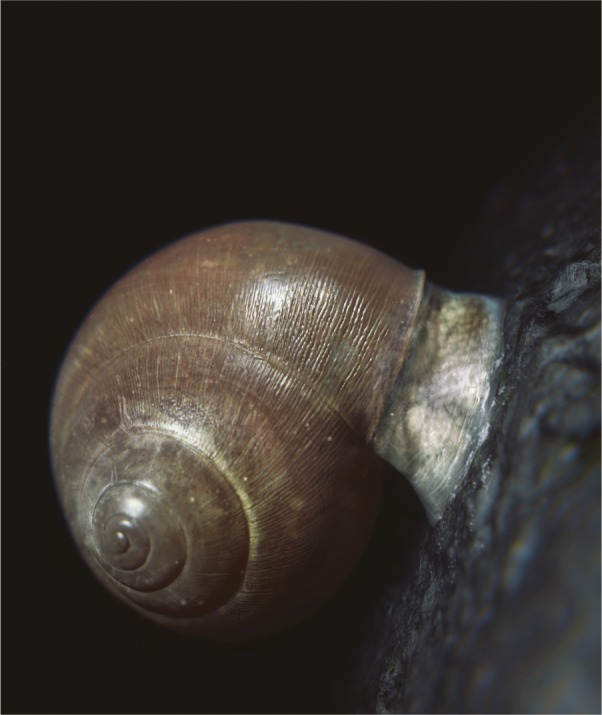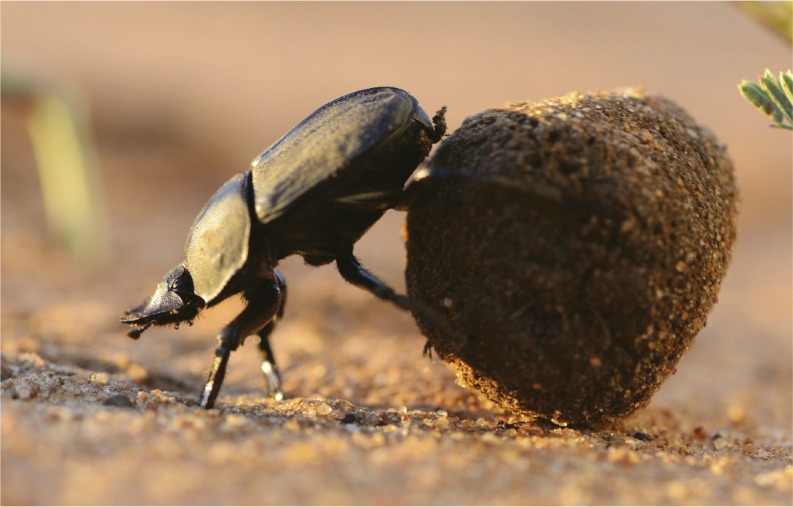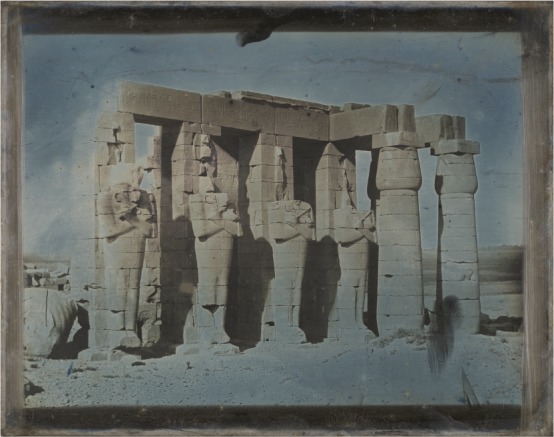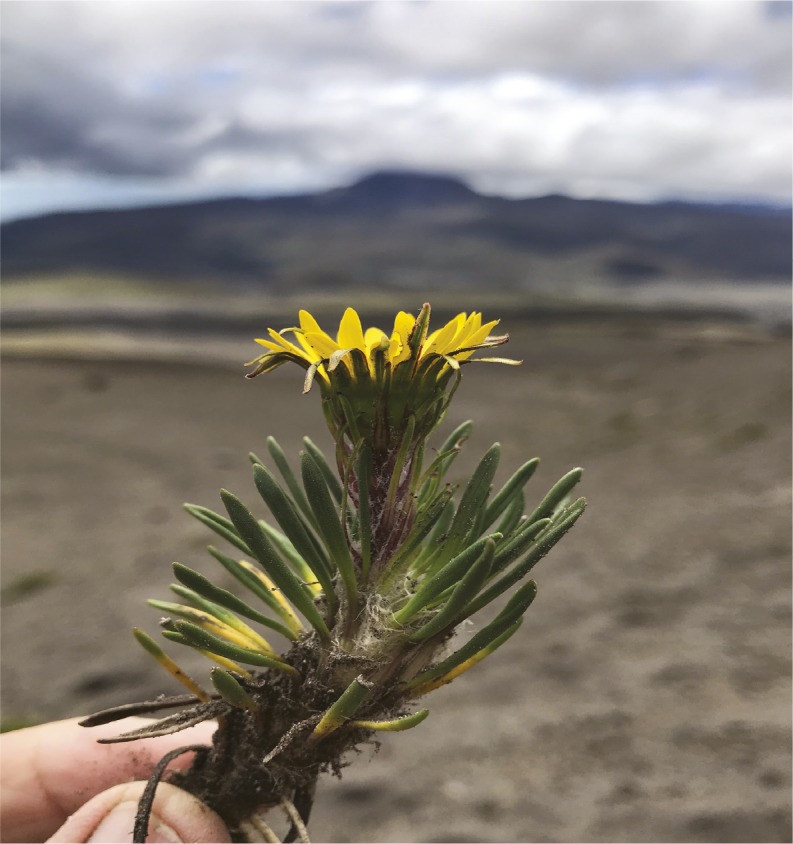Snail-inspired superglue

Land snail adhering to a rough surface using its epiphragm. Image courtesy of Younghee Lee (photographer).
Commercial adhesives are either strong and irreversible, such as superglues, or weak and reusable, such as pressure-sensitive tapes. Some biologically inspired adhesives such as Velcro are both strong and reversible, but they require interlocking structures on opposing surfaces for adhesion. To create a strong and reversible adhesive that works on an array of surfaces, Hyesung Cho, Gaoxiang Wu, Jason Christopher Jolly, et al. (pp. 13774–13779) fashioned a hydrogel that combines the desirable properties of liquid and dry adhesives, drawing inspiration from snails. Snails glide along rough and uneven surfaces, secreting mucus, which provides traction. As the mucus dries and hardens, its shear modulus rises from 100 Pa to 1 GPa, resulting in a structure called an epiphragm, which cements the snail to the surface. The authors developed a reversible hydrogel made of poly(2-hydroxyethyl methacrylate) (PHEMA) that works on smooth and rough surfaces, with adhesive strengths reaching 892 N/cm2, comparable to superglues. Like the snail’s epiphragm, the gel deforms in its soft, wet state to adapt and adhere to the target surface. Upon drying, the gel shrinks, turns glassy, and interlocks with the surface, its shear modulus increasing by 3 orders of magnitude to around 2.3 GPa. Rehydrating the gel liberates the stored energy, restores the gel’s original shape, and quickens detachment—a physical attribute termed shape adaptation and memory. The authors scaled up the adhesive by layering the hydrogel atop a silicon backbone attached to a tendon made of Kevlar tape. Using only a pair of 2 cm2 samples of the hydrogel, the authors demonstrate that an adult human weighing 87 kg can be suspended from the adhesive rig. Additionally, the authors used a structured PHEMA gel pad to detach the wing scales of morpho butterflies without damaging the scales’ gossamer microstructures—a task too delicate for liquid glues. According to the authors, the PHEMA hydrogel can be scaled up and chemically modified for an array of applications. — P.N.
Improving functional recovery after stroke
Stroke is a major cause of disability, and the lack of an effective therapy that promotes long-term recovery represents an unmet medical need. Angiogenesis, or the formation of new blood vessels, has been proposed as a therapeutic target, but treatments that promote angiogenesis after cerebral stroke are lacking. Ruslan Rust et al. (pp. 14270–14279) provide evidence in mice that blocking a molecule called Nogo-A, which inhibits angiogenesis and the growth of neuronal projections, promotes vascular and neural repair as well as functional recovery after ischemic stroke, which occurs when an artery that supplies oxygen-rich blood to the brain becomes blocked. Both genetic deletion of Nogo-A and treatment with an antibody that blocks Nogo-A increased the number of newly formed blood vessels and improved behavioral performance on motor tasks assessing stroke-affected limb function 3 weeks after injury. Treatment with the anti–Nogo-A antibody also improved the survival of neurons and connections between neurons, increased levels of the neurotransmitter dopamine, which plays a key role in motor function and recovery, and increased the density of nerve fibers near the damaged tissue 3 weeks after injury. According to the authors, anti–Nogo-A antibodies, including an antibody in clinical testing for spinal cord injury, could represent an angiogenesis-promoting therapeutic strategy for ischemic stroke. — J.W.
Dung beetles use a flexible compass for spatial orientation

Dung beetle. Image courtesy of Chris Collingridge (photographer).
South African dung beetles sequester food by shaping pieces of dung into spheres that are spirited away from competitors in the savanna. To hasten their getaway, the beetles scurry in a straight line away from the dung pile, using the sun’s position to align themselves as they haul their meal. However, as the midday sun rises in the sky, the beetles’ ability to draw positional cues from it wanes. To determine how the beetles maintain their heading despite being deprived of this crucial cue, Marie Dacke et al. (pp. 14248–14253) tested the beetles’ behavior under a series of controlled solar elevations and wind speeds in outdoor and indoor arenas. At high solar elevations, the beetles relied on a wind compass, rather than the sun’s position, to find their bearing; the authors monitored wind direction and speed in the beetles’ natural habitat and found that the speed peaks when the sun is at its zenith. Wind cues improved the precision of the beetles’ orientation. Compared with beetles with intact antennae, beetles whose antennae had been amputated oriented poorly along a given direction, suggesting that the beetles perceive mechanosensory cues using their antennae, likely mediated by a structure called the Johnston organ. Importantly, the beetles were capable of transferring sensory cues between the sun and wind compasses depending on solar elevation, suggesting a composite compass snapshot undergirded by a common neural network for spatial memory. The findings uncover the role of a flexible, multisensory compass for spatial orientation in dung beetles, according to the authors. — P.N.
Bubble pinch-off in confined conditions

Sequence of snapshots showing neck shrinkage and eventual bubble pinch-off in a capillary tube.
The pinch-off of a bubble involves formation of a singularity, which is expected to be independent of the details of the experimental setup and thus to exhibit universal dynamics. However, bubble pinch-off has been shown to be nonuniversal when it occurs in a large tank of viscous liquid. Amir Pahlavan et al. (pp. 13780–13784) explored the dynamics of bubble formation and pinch-off in the highly confined conditions within a capillary tube. Whereas in a large tank the neck of the bubble contracts linearly with time, the neck of the bubble in a capillary tube contracted in 2 distinct stages. Initially the neck radius varied with the 1/5 power of time, before transitioning to a linear dependence on time shortly before pinch-off. Unlike the case of liquid in a large tank, bubble formation in the capillary tube was insensitive to the details of the experimental conditions. The first stage of pinch-off, driven by movement of the contact line where liquid, gas, and solid phases meet, effectively erases the memory of the system, leading to universal dynamics. According to the authors, the results have implications for bubble and drop formation in confined conditions, such as in microfluidic technology and geophysics. — B.D.
Nanoparticles underlie optical effects of earliest photographs

Ramesseum, Thebes, 1844. Girault de Prangey, The Metropolitan Museum of Art. Purchase, Mr. and Mrs. John A. Moran Gift, in memory of Louise Chisholm Moran, Joyce F. Menschel Gift, Joseph Pulitzer Bequest, 2016 Benefit Fund, and Gift of Dr. Mortimer D. Sackler, Theresa Sackler and Family, 2016 (2016.604).
The daguerreotype is the earliest photographic technology that successfully captured an image from a camera, with extraordinary resolution and clarity even by current standards. The preservation of daguerreotypes, which are records of history and culture, requires an understanding of the physical and chemical mechanisms underlying their optical response. Andrea Schlather et al. (pp. 13791–13798) combined daguerreotype artistry and expertise, experimental nanoscale surface analysis, and electromagnetic simulations to perform a comprehensive analysis of these early photographs. The findings showed that the scattering spectrum of individual nanoparticles on the daguerreotype surface consists of a narrow, blue/UV peak as well as a broader red peak. As a result, the daguerreotype exhibits a blue tone when viewed from above, but the tone shifts to brown/red as the viewing angle increases. Moreover, the scattering spectrum of the nanostructure is strongly affected by particle morphology and size, but not composition. For example, decreasing nanoparticle height leads to a blueshift in the spectrum, whereas increasing overall nanoparticle dimensions causes a redshift and broadening of the spectral peak and diminishes the angle-dependent color effect. According to the authors, these insights could be used to develop preservation protocols and novel color printing technologies. — J.W.
Origin and diversification of sunflower family

Werneria pumila Kunth, an endemic South American genus that resulted from explosive diversification out of Africa in the middle Eocene.
The sunflower family, composed of an estimated 25,000–30,000 species, accounts for nearly 10% of all flowering plants. Global in distribution, the family occupies nearly every type of habitat on Earth and is marked by a complex inflorescence as seen in the North American sunflower, in which individual flowers are clustered to mimic a single large flower to lure pollinators. However, the origins, migration routes, and patterns of diversification that led to the family’s ecological success remain unclear. Using phylogenetic analysis of nearly 1,000 genomic locations in around 250 species, Jennifer Mandel et al. (pp. 14083–14088) found that the family likely originated around 83 million years ago in the Late Cretaceous Period in southern South America. The earliest diversification out of South America may have occurred around 56 million years ago, during a period of dramatic climate change. Subsequently, the family rampantly diversified during the middle-to-late Eocene Epoch, 42–37 million years ago, a period marked by global cooling, resulting in more than 95% of existing species. Biogeographical analysis suggests that the family migrated to North America, south and central Africa, and Asia, with ancestral range estimates suggesting different possible dispersal routes out of South America. Regardless of the actual route, the family’s prolific diversification and global colonization likely began once it reached Africa around 42 million years ago. According to the authors, the findings illuminate the evolutionary processes underlying the wide reach and vibrant diversity of a major group of flowering plants. — P.N.


